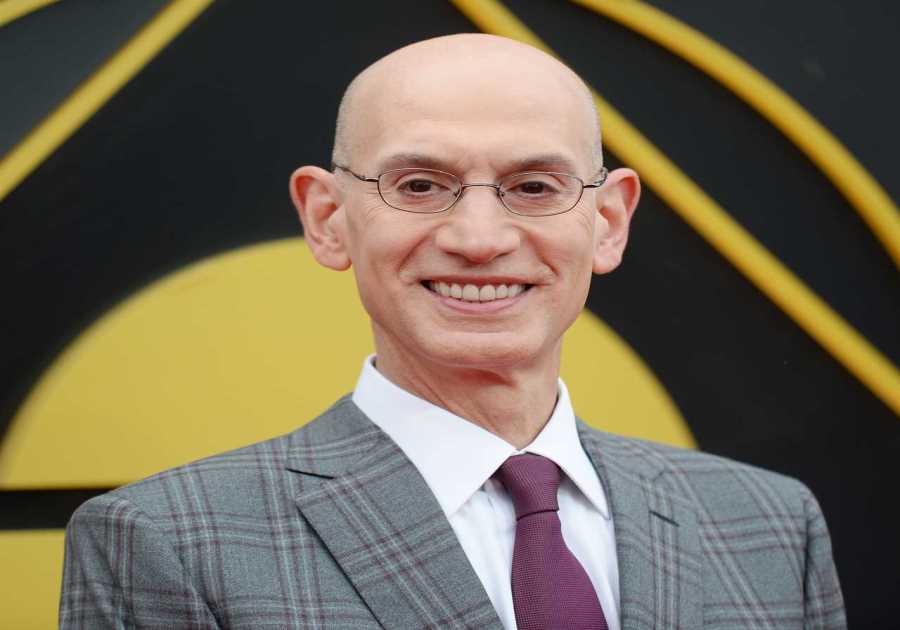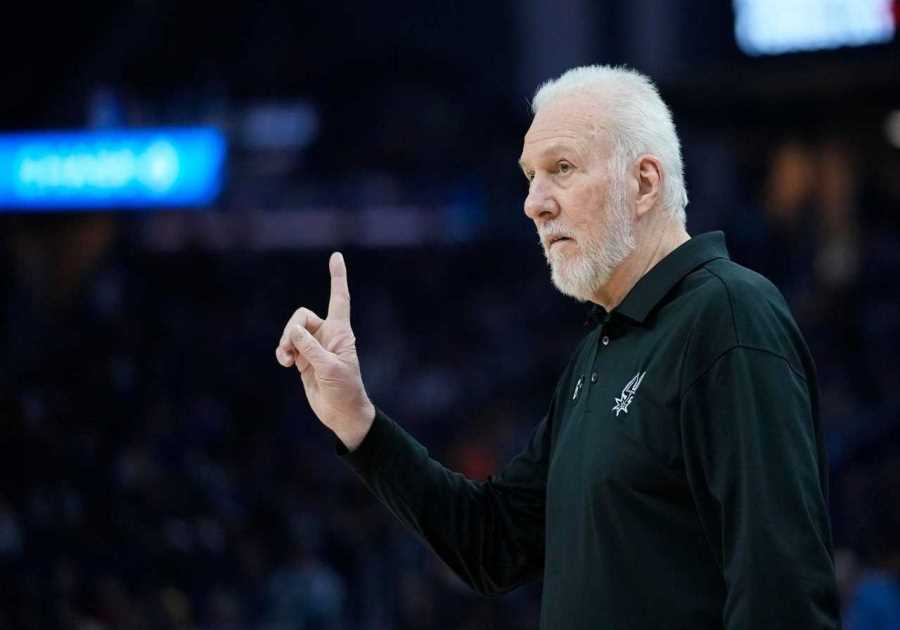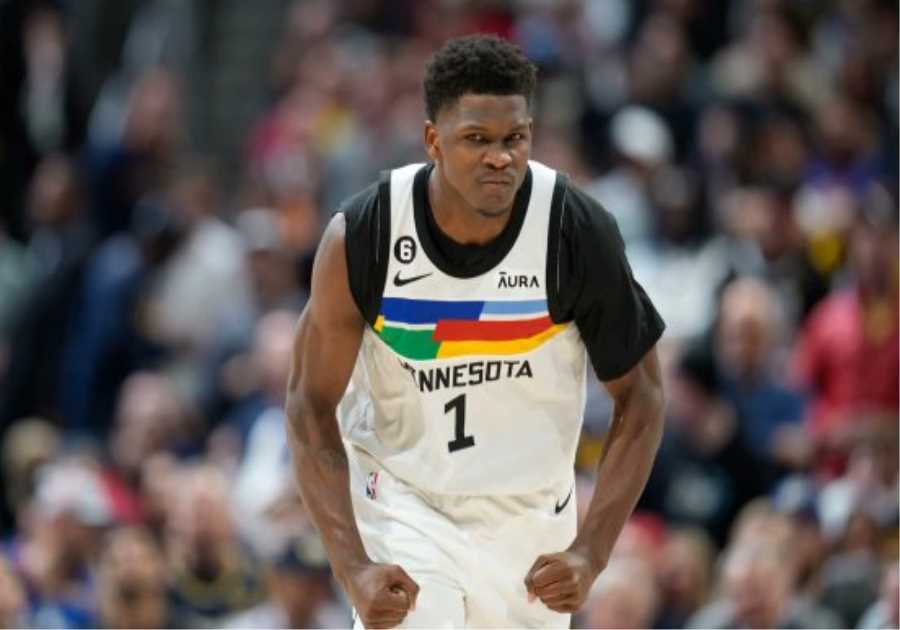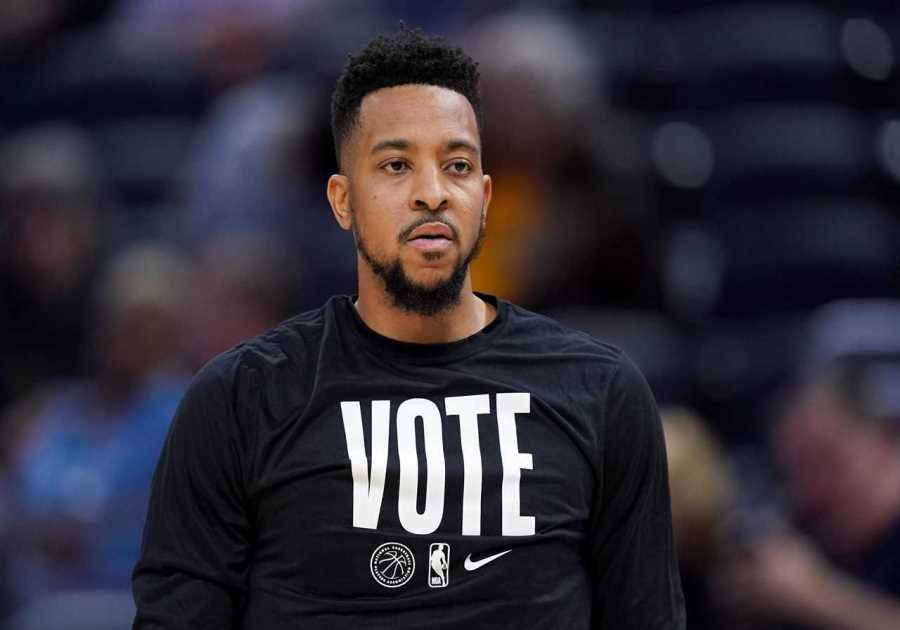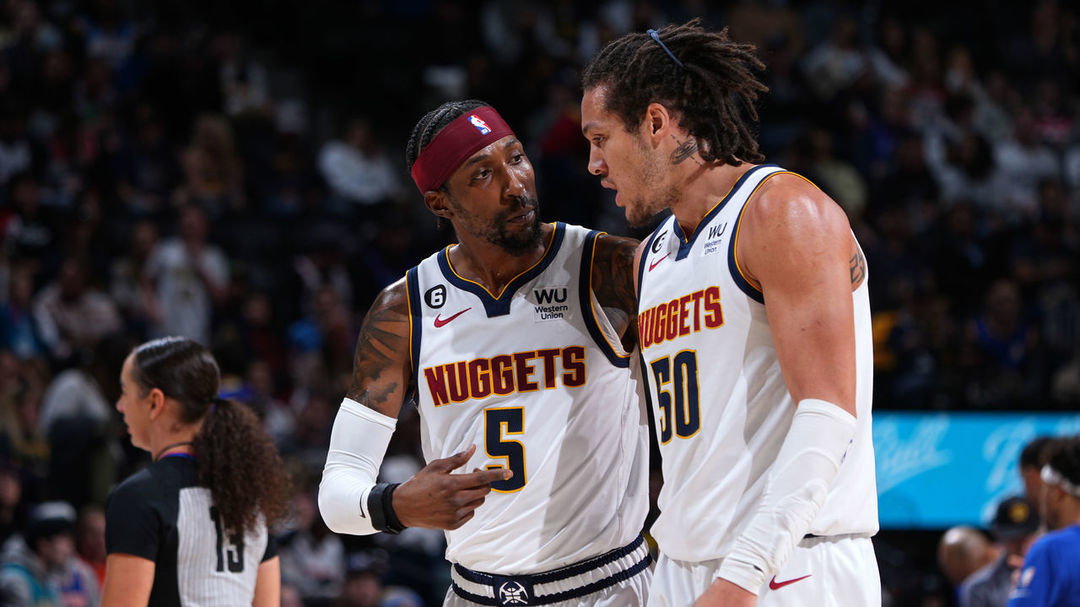
Back on Dec. 14, the Denver Nuggets claimed a piece of NBA history by scoring a modern-day record 98 paint points en route to a 141-128 win over the Washington Wizards. The game perfectly encapsulated the Nuggets at that point in the season: They couldn't be stopped, nor could they get stops. Afterward, head coach Michael Malone acknowledged the incredible offensive achievement but in the same breath sounded the alarm about his team's punchless defense.
"You can win regular-season games like that, but you're not gonna win a playoff series if your recipe is to outscore teams," Malone told reporters. "I don't like winning games when it's just offense, and that's gotta change at some point. ... It's going to bite us in the butt here soon."
Sure enough, two nights later, the Nuggets suffered arguably their worst loss of the season - a 126-108 beatdown at the hands of a Los Angeles Lakers team that played without Anthony Davis for the entire second half. Malone was exasperated.
"Everything we stressed going into the game, we did nothing to stop any of those," he said. "(We gave up) 64 in the paint, 30 in transition, 18 on the glass. ... Like, what are we doing out here? Are we just wasting our time, going through the motions?"
The Nuggets were a respectable 17-11 at the time thanks to their Nikola Jokic-led offense. But they ranked 28th in defensive efficiency, allowing more than 115 points per 100 possessions. Their pick-and-roll coverage was getting picked apart. Their bench was bleeding points. They were getting lit up from 3-point range, gashed at the rim, and torched in transition. It wasn't exactly a recipe for title contention.
Garrett Ellwood / NBA / GettyThe roster makeup never screamed defensive juggernaut, but the extent of the Nuggets' ineptitude at that end was mystifying considering they had quality individual defenders such as Aaron Gordon, Kentavious Caldwell-Pope, and Bruce Brown logging heavy minutes, and that their other key contributors (with a couple of notable exceptions) were about average.
"There's no way in hell we should be 28th in defensive efficiency," Malone said. "You can't tell me that in my eight years in Denver, this is our worst defensive team. No one can ever convince me of that."
Once again, the coach proved prescient. Since that Lakers loss, the Nuggets are 11-2 with the league's second-best defensive rating (109.8). That surge has them tied atop the Western Conference standings and up to 19th on defense for the season. So, what's powered that dramatic turnaround? And can it hold?
Let's get this out of the way first: When a bad defensive team suddenly becomes good, opponent shooting variance is almost always a significant factor. That doesn't tell the entire story here, but it certainly tells part of it. Opponents have hit just 32.2% of their threes during this 13-game stretch (including just 28.1% from above the break), the lowest percentage any team has surrendered over that timeframe. Opponents have also hit just 40.5% of their non-rim 2-pointers, the fifth-lowest mark allowed during this stretch. Simply regressing those numbers to league average would put Denver's defense back around where it was early on.
But that doesn't mean there haven't been encouraging signs of growth and a much better defensive process overall. The Nuggets have been far more proactive and connected with their rotations, more adept at helping the helper, and a bit more flexible with their coverages. (More on that in a minute.) Denver's base pick-and-roll scheme brings the screen defender (typically Jokic) up high and momentarily puts two guys on the ball, which places a ton of pressure on their low man to tag the roller and recover out to the perimeter. That's been a major area of improvement recently, with Gordon and Brown doing a lot of the heavy lifting.
At the rim, where teams tend to have more control over how their opponents shoot, the Nuggets have shaved their field-goal percentage allowed from a disastrous 70.5% down to 68.4% during this run, according to Cleaning the Glass. That doesn't seem like much, but it represents a jump from 29th in the league to 16th because of the way offense keeps trending up.
It's worth noting that Michael Porter Jr.'s return from a heel injury coincided almost exactly with the team's defensive upswing, and there's a genuine correlation there. That might be hard to believe given Porter's obvious warts, but simply having his 6-foot-10 frame on the back line makes a big difference in short-roll deterrence, especially when Gordon is the guy defending the ball-handler in the pick-and-roll.
On top of simply bringing size, Porter has improved immeasurably as an off-ball defender. He's gotten a much better feel for the timing of those low-man rotations and for playing between two guys when zoning up the weak side. He's making crisp X-outs and balanced closeouts:
Your browser does not support the video tag. TNTMeanwhile, Jamal Murray's return to form as a stout one-on-one defender and screen navigator has really fortified things on the perimeter, while Caldwell-Pope has proved to be an invaluable addition on that front.
Here's an example of all the pieces working together in harmony from the Nuggets' epic beatdown of the Clippers last week:
Your browser does not support the video tag. TNTThe Clippers run a double ball screen; Gordon switches the first one, Jokic shows high on the second, Porter pre-rotates to tag the roll, Caldwell-Pope snuffs out the skip pass with a long closeout to the corner, Porter completes an X-out to take away the above-the-break three, Gordon forces Paul George into a contested pull-up mid-ranger, and Jokic caps it off by inhaling the rebound.
The Nuggets have also meaningfully cut down on opponent 3-point attempts, without a corresponding bump in rim volume. Instead, they've managed to reroute a chunk of those threes into the mid-range area for long twos and floaters.
And if you want to argue that their opponents' sudden decline in long-range accuracy isn't a fluke, point to the fact that the Nuggets are forcing teams to dribble into more of their shots than they were before and are allowing the 10th-fewest wide-open threes per game since the Lakers loss, 2.1 fewer than they were conceding up to that point, according to NBA Advanced Stats.
Anecdotally, it feels like many of the threes they've allowed lately are of the contested variety, more a product of stagnation than rotation-beating ball movement:
Your browser does not support the video tag. Altitude SportsMalone has also tinkered with different schemes that change the way Jokic operates within the defense, sprinkling in more zone, pre-switching, and "next" help in order to keep him closer to the basket and out of high ball-screen action. That was a particularly prominent tactic in the Nuggets' win over the Memphis Grizzlies last month, a game in which Denver allowed just 91 points. It also helped the Nuggets flip a game against the Cavaliers a couple of weeks later, a would-be schedule loss that turned into a rousing win on the second night of a back-to-back:
Your browser does not support the video tag. Altitude SportsThe Nuggets don't like to use Jokic in a drop because containing the ball while backpedaling is probably the thing he struggles most with defensively. Having him up at the level utilizes his size and quick, sticky hands in a more productive way. But zones and pre-switches can work well for Jokic because they allow him to be a disruptor near the basket from a stationary position:
Your browser does not support the video tag. Altitude Sports In that Grizzlies game, the Nuggets did also mix in a lot of standard drop coverage for Jokic. They haven't returned to that well too often since, but they should feel more comfortable doing so now that they have guys they can trust to fight over screens and stay attached to ball-handlers (i.e. Caldwell-Pope, Brown, and more recently Murray). That simply hasn't been the case for their point-of-attack defenders in recent years. For a defense that's skewed one-dimensional, having those wild cards to play can be extremely important.
Even when their opponents' shooting regresses to the mean, the Nuggets can hang their hats on their ability to guard without fouling and clean the defensive glass. That second point is particularly important, and it's powered by Jokic's underrated ability to get out to the perimeter and veer back in time to snatch the ball off the rim with his giant meat paws. All told, the starting lineup of Murray, Caldwell-Pope, Porter, Gordon, and Jokic has a 104.5 defensive rating, which is miles better than the Cavaliers' league-leading mark for the season and second-best of any five-man combination that's played at least 200 minutes. (That group's plus-16.6 net rating also ranks second, behind only the Warriors' starters.)
The bench is where the struggles have been most pronounced, but that's slowly getting smoothed out as well. Pulling DeAndre Jordan from the rotation in favor of Zeke Nnaji has helped stabilize the second unit's defense, even though it leaves that group a tad small up front. Vlatko Cancar has taken Jeff Green's spot with those units while Green recovers from a fractured hand, but he'll be hard to bump if he continues to shoot the ball and compete on defense the way he has recently.
Bones Hyland remains a glaring minus, and that's something Malone will have to wrangle with when the games start to really matter. His preferred transitional lineup right now is a Murray-and-bench group, which keeps the offense afloat while Jokic sits but may not be tenable defensively. In 236 minutes with both Hyland and Murray on the floor, the Nuggets have surrendered 124.1 points per 100 possessions. Malone has had Gordon on the court with Jokic off for just 77 minutes this entire season. Although the defense in those minutes hasn't been good either, you wonder if at some point he'll give it a longer look.
There are other red flags that support Malone's earlier concerns about postseason viability. The Nuggets continue to rank dead last in transition defense (135.4 points allowed per 100), and they're getting burned particularly badly off of live-ball rebounds, per Cleaning the Glass. Neither of those things has improved during this run. (It does help that the Nuggets simply don't miss many shots; as a result, they're actually one of the league's best teams at preventing opponents from getting out on the break.)
For all Porter's strides as a help defender, his on-ball work is still a mess, and the Nuggets encounter problems when teams involve him in ball screens. We've seen teams like the Celtics opt to attack him instead of Jokic, spacing the latter out to the corner and forcing him to make the help-and-recover decisions while Porter tries to contain the ball. We've also seen teams exploit his poor screen navigation by using double-drag actions that force him to switch onto the ball and then navigate the ensuing pick. Denver should keep experimenting with schemes that keep not only Jokic but also Porter out of those actions on the perimeter.
Jokic's rebounding and at-the-level activity make up for a lot, but his lack of lateral agility (ball-handlers still turn the corner on him regularly) and poor rim protection still make him a less-than-ideal defensive anchor on the whole. Plenty of great rim-protectors have mastered the craft without the benefit of elite vertical athleticism, but Jokic hasn't gotten there because he's frequently late and noncommittal with his back-line help. That largely has to do with him prioritizing rebounding position over shot contests, and given how toothless his contests can be, that's probably the right approach. It doesn't change the fact that scheming around his limitations against elite playoff offenses will be a significant challenge.
And yet, the Nuggets' offense is so good that it might not matter. Their defense only needs to be passable for them to contend, and what they've done this past month, even if it's unsustainable over long periods, has proved they're at least capable of being good enough on that side of the ball.
As Malone crowed after the Nuggets kickstarted this turnaround a month ago with their first in a long line of acceptable defensive showings: "I'm gonna stick that in a pipe and smoke it."
Copyright © 2023 Score Media Ventures Inc. All rights reserved. Certain content reproduced under license.
Joe Wolfond
https://www.thescore.com/nba/news/2544182
By: Joe Wolfond
Title: Should we believe in the Nuggets' defensive turnaround?
Sourced From: www.thescore.com/nba/news/2544182
Published Date: 01-12-2023
Frequently Asked Questions
Who invented basketball?
The exact origins of basketball are unknown, but it is widely believed that James Naismith created the game in 1891 while he was a teacher at the International Young Men's Christian Association (YMCA) Training School (now Springfield College) in Springfield, Massachusetts. Naismith wrote the basic rules and nailed a peach basket onto an elevated track. He divided his class of 18 into teams of nine players and set about to teach them the basics of his new game, which he called "Basket Ball." The original version was played with a soccerball and two peach baskets, which were attached to each side of the gym. Players could only shoot at the basket from below; goaltending was not yet a part of the game. The game spread rapidly across America. In the early 1900s, professional basketball teams were playing in large arenas. It is today one of the most loved sports in the world.
How long can a player stay on waivers for?
If a NBA basketball player is let go during the season by their club, they are considered waived. Waived NBA players are eligible for a waiver 48 hours before another team can claim them. If the player is claimed by more than one team, priority will be given to the team with a poor record.
Which NBA star is the most dominant scorer in the league now?
Because different players have their own styles of play, the answer to this question can be subjective. Kevin Durant (LeBron James), Stephen Curry, James Harden, and Stephen Curry are the top choices for most dominant scorers in the NBA.
Kevin Durant's not just a great shooting player, but he is also an offensive force! This player is a serious player with two NBA Championships, 2 Finals MVPs, and a regular season MVP title.
What are Bird Rights in NBA Basketball?
"Bird rights", a term in the NBA that allows players to be signed by their current NBA team for more money, is known as the NBA's Bird Rights. This rule is named after Larry Bird (ex-Boston Celtics player), who was the first to profit from it. If a player has been on the team's roster for more than three years, the salary cap limit can be exceeded to allow a team to sign another player. Bird rights allow players who are not currently with the team to retain their status and earn a higher salary than what they would get from any other teams.
What is the most accomplished NBA team of all time?
This question will be debated for many years by fans. Los Angeles Lakers, Boston Celtics have the most NBA titles with 17, while the Boston Celtics has 17. Chicago Bulls' glory years were in the 1990s under Hall of Fame coach Phil Jackson. The San Antonio Spurs have won five championships since 1999, and the Golden State Warriors won four titles in the last decade. Other notable NBA teams include: the Philadelphia 76ers in 1980, the Kobe Shaq Lakers from 2000s, LeBron James's Miami Heat squad that won back–to-back championships (2012) and 2013.
Who is the greatest free throw shooter of all?
It is a question that is often debated by basketball fans. However, most agree that Stephen Curry of Golden State Warriors is undoubtedly the greatest free-throw sapper of all time. This incredible player holds the record for most 3-point conversions per season, with an astounding 402.
Karl Malone currently holds a record for the most free throws made over a career with 9,787 success shots. With 13,188 attempts, Karl Malone also holds the record for most free throws attempted. This has resulted to a 74.20% success percentage.
Statistics
- The 2013–14 season opened with 92 international players on the opening night rosters, representing 39 countries and over 20% of the league. (en.wikipedia.org)
- The 2013–14 season opened with 92 international players on the opening night rosters, representing 39 countries and over 20 percent of the league. (en.wikipedia.org)
- Williams would 'likely' accept a deal worth $14-15M/year; Celtics are 'unlikely' to offer such a deal (HoopsHype) (bleacherreport.com)
- The opening game of the 2020 Finals between the Los Angeles Lakers and Miami Heat brought in only 7.41 million viewers to ABC, according to The Hollywood Reporter. (en.wikipedia.org)
- An estimated 800 million viewers watched the [105]2017–18 season. (en.wikipedia.org)
External Links
si.com
- NBA Free Agency Preview. The Biggest Question and Rumors
- Free From Quarantine: The NBA Bubble Is A Unique Experience
nba.com
twitter.com
- Tweet / Follow Twitter
- Sam Amico on Twitter: "Timberwolves Waive PJ Dozier, CJ Elleby and AJ Lawson - Hoops Wire https://t.co/xKu1ZTuQZN" / Twitter
basketball-reference.com
- Thomas Bryant Stats, Height, Weight, Position, Draft Status and more | Basketball-Reference.com
- Dennis Schroder Stats, Height, Weight, Position, Draft Status and more | Basketball-Reference.com
How To
Is it possible to get paid by the NBA for injuries sustained by players?
Guaranteed contracts allow NBA players to keep their money even if they are injured or unable to play. Some have even made millions of dollars without ever playing a single game. Although they might lose out on bonuses and their contract could be cancelled after expiration, they will still receive the full amount. Non-guaranteed contract players won't typically be paid until they are able to play again in the NBA. The NBA can provide some assistance with disability payments or a lump sum settlement for those who qualify, but there is no guarantee of pay during an injury absence. Teams and the league can also help those who are in greatest need.
The Injury Disability Plan can be used to help teams. Ultimately, it depends on the individual and his team's situation. In some cases, players may be able to negotiate a buyout with their teams to receive some money during their injury absence. Although there are no guarantees regarding payment, players should understand that the league and their team can assist them. Each situation is different and should be evaluated individually. The NBA has detailed rules for injuries and payment during injury absences. Knowing these rules can help players make agreements with their teams, or to make informed financial decisions about the future. For any questions or concerns, it is important that you consult a professional.

